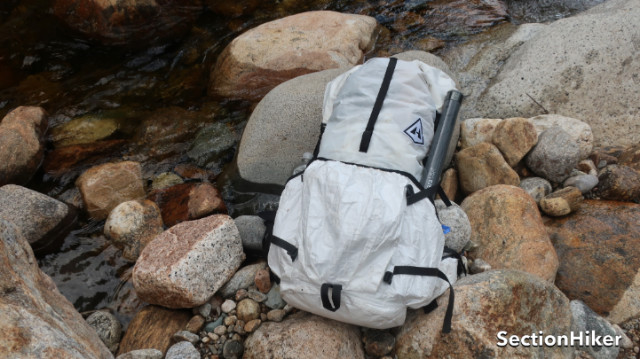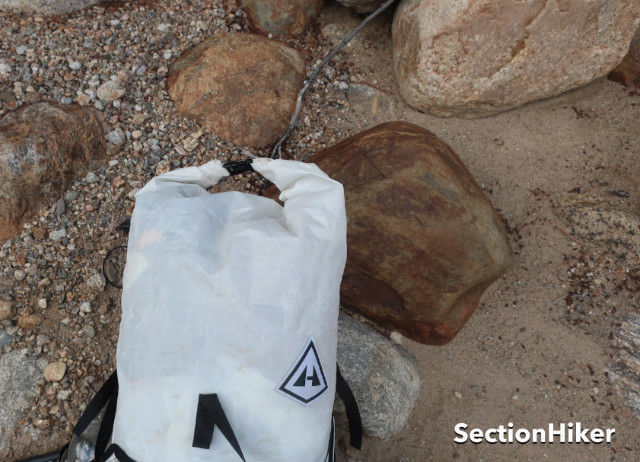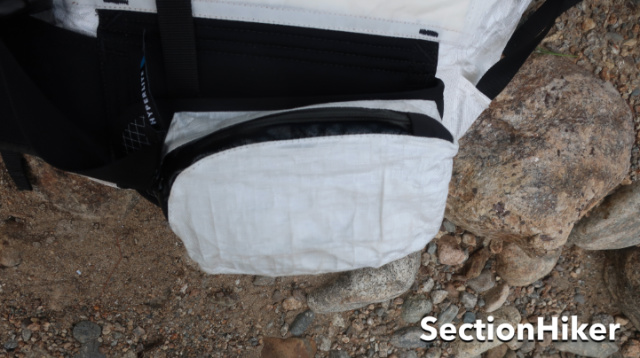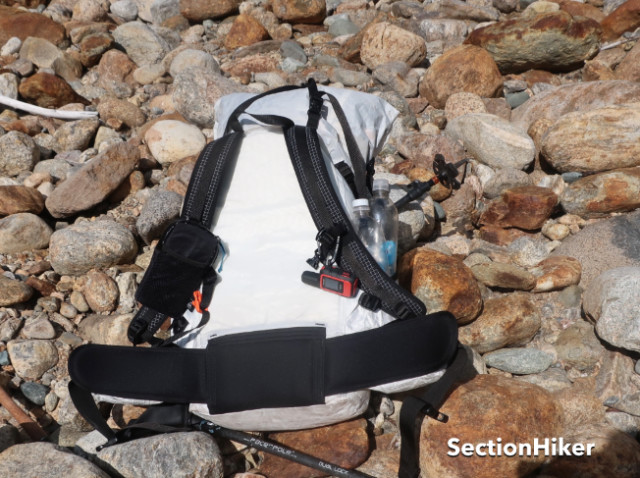The Hyperlite Mountain Gear NorthRim 55 Backpack is an ultralight backpack made with an extremely durable outer fabric called Woven Dyneema that is significantly more abrasion resistant than the Dyneema Fiber/Polyester laminate used to make Hyperlite’s regular ultralight backpacks. While it’s priced at a premium, the NorthRim is definitely worth upgrading to over Hyperlite’s other backpacks if you spend the majority of your time hiking off-trail, you’re very hard on backpacks, or just want one that will last for more than a few years.
Specs at a Glance
- Weight: 34.4 oz
- Gender: Unisex
- Pockets: 5+ main
- Color: Any color as long as it’s white.
- Type: Frame (frame stays)
- Hydration compatible: No
- Seam-taped: Yes
- Bear Canister Compatibility: Vertical: BV500; Horizontal: BV475, BV450, BV425
- Internal Volume: 55L (3400 cubic inches)
- External Volume: 9.8L (500 cubic inches)
- Materials: 150D Dyneema/Polyester Laminate (Main Body) + 375D Woven Dyneema (Bottom + External Pockets)
- Maximum Recommended Load: 40 lbs
- For complete specs, visit Hyperlite Mountain Gear
The Value of Woven Dyneema
The Hyperlite Mountain Gear NorthRim 55 is nearly identical to every other 55 liter backpack the Hyperlite makes except for the fact that the bottom of the pack and the exterior pockets are made with Woven Dyneema. Woven Dyneema is an order of magnitude more durable than the Dyneema/Polyester laminate that Hyperlite uses on their less expensive backpacks and is worth paying a premium for if you want a pack that will survive heavy use in highly abrasive terrain. (Note: We compare Woven Dyneema and Ultra 400, a newer durable woven fabric below.)

Abrasion occurs whenever you set your pack down on sandy ground or gravel; when your pack brushes against canyon walls and rock faces; or you bushwhack off-trail where the vegetation whacks back. Do it enough and the backpack fabric gets thinner and thinner until holes form and it becomes unsalvageable, no matter how much duct tape, Tyvek tape, and Shoe Goo you use to patch it up. I’ve worn irreparable holes in the bottoms of the Hyperlite Mountain Gear Southwest 40 and SouthWest 55 backpacks from abrasion, so I have first-hand experience in this department.
But the Woven Dyneema on the exterior of the Hyperlite North Rim 55 is much more abrasion resistant than the Dyneema/Polyester laminate used in Hyperlite’s other backpacks because it is made by weaving together Dyneema fibers, which are stronger than steel, into cloth, rather than gluing a small percentage of Dyneema Fibers to 50D or 150D Polyester, which is the material that Hyperlite uses in their other backpacks.

Hyperlite’s NorthRim backpack is notable because it is arguably the first off-the-shelf backpack that incorporates Woven Dyneema as a fabric. While Cilogear and Alpine Luddites offer Woven Dyneema as a fabric option on their packs, they mainly sell more expensive, custom-made packs for climbers where abrasion is also a concern.
Backpack Storage and Organization
The Hyperlite Mountain Gear NorthRim 55 Backpack is laid out in a traditional ultralight style with a large main compartment, side water bottle pockets, and a large rear pocket. The main compartment has a dry-bag style closure system which provides excellent top compression for stabilizing your load. The ends of the dry bag closure can be clipped together on top of the pack or secured to straps along the sides. When doing so, the loose straps can be clipped together on the front side of the pack, providing a nice attachment point for bulky gear.

The top of the roll top has a velcro stiffener to facilitate rolling and hold the two sides together. Some people find the velcro stiffener to be a nuisance because it catches on clothing. Over time and repeated rollings, the stitching, and material holding the velcro degrades and throws off threads, though the complete failure of the roll top is unlikely.

There are five external pockets on the NorthRim 55 backpack, two side water bottle pockets, a larger front stretch pocket, and two hip belt pockets. All of the pockets are made with Woven Dyneema. There’s no external mesh to dry damp gear. The large front stretch pocket has a drain hole in the bottom, but the side pockets don’t. Water bottles stored in the side pockets are also reachable and replaceable while wearing the pack, a must-have, but they have a tendency to pop out when bushwhacking or scrambling. The hip belt pockets, which have been enlarged by Hyperlite in recent years to make them useful, have waterproof zippers and zipper pulls, a usability detail left off of many ultralight backpacks.
While the external pockets and the base of the pack are covered in Woven Dyneema, the interior pack bag is made with the 150D Dyneema/Polyester laminate that Hyperlite uses on their other backpacks. That’s fine because all of the high abrasion points are covered with more durable Woven Dyneema. The interior pack bag is seam-taped and it is NOT hydration compatible: there are no hose ports and there is no hydration sleeve, although there is an internal webbing loop where you could hang an accessory pocket or bladder from. This pack is recommended for packrafting and having hose ports would be a non-starter in terms of keeping the interior dry.

When I pack the NorthRim, I put my sleeping bag stuffed in a dry sack at the bottom of the pack and then stack my food bag on top of it, stacking my tent or hammock and other heavy items up the back panel as I go. I stuff lighter-weight insulating layers and clothing behind the heavier items to hold them in place and then put my lightest items in the extension collar (mainly clothing and personal effects). I then use the pack’s roll-top to compress the items in the extension collar and shrink the volume they require. This weight and volume distribution provides the best load control since heavy items are located near my hips and there’s a direct transfer of kinetic energy from my core to items located just above the small of my back.
Backpack Frame and Suspension

Hyperlite uses a very simple but effective frame system in all of its multi-day backpacks. The packs use frame stays which are pre-bent aluminum rods housed in stay pockets inside the pack behind the shoulder straps. They can be removed and bent to customize the pack for your dimensions, but they should work for most people out of the box. The shoulder straps are sewn directly to the interior pack bag just above the frame strays, which terminate behind the hip belt. The hip belt is sewn onto the backpack and not removable, which is quite effective in bringing the pack close to your hips for load transfer.
Load lifters are notably absent on Hyperlite’s backpacks (See #13 in this interview with founder Mike St Pierre) because proper back panel sizing obviates their necessity, according to Hyperlite. I’ve used four Hyperlite backpacks and never missed load lifters because the pack sits very close to my back, preventing it from canting backways.

I attribute this to three factors: torso length fit, the attachment point of the shoulder straps, and the sewn-on hipbelt. Perhaps it’s luck, but a size large Hyperlite pack fits my torso perfectly, while the shoulder straps and hip belt position the pack very close to my torso so the pack feels like an extension of my body rather than a hitchhiker. It’s not so good in hot and humid weather because there’s no back ventilation, but the fit is out of this world.
The hip belt of the NorthRim is lightly padded with a stretch mesh which is what I prefer for a good hip wrap, with a beefy front buckle for durability. You don’t need a giant hip belt for lighter-weight loads. A big buckle is also a must-have for winter backpacking since small hip belt buckles fill with snow and become impossible to close. (It’s one of the reasons why UL backpacks make sucky winter packs.)

The shoulder straps also have light padding, with sewn-on daisy chains that make it easy to add accessory pockets, like the iconic Hyperlite Mountain Gear Waterproof Shoulder Strap Pocket, water bottle sleeves, or a satellite messenger to the straps. The sternum strap slides up and down the daisy chain webbing and is easy to reposition. But the shoulder straps are only available in a standard J-shape, so they’re less desirable for people with breasts or sloping shoulders. The hip belt is similarly “unisex” without provision for female backpackers.
Backpack Compression and Attachment Points
The NorthRim 55 has two tiers of side compression straps that can be used to attach gear to the outside of the pack. A bottom compression strap runs horizontally outside each water bottle pocket, while the upper strap is oriented at a diagonal to bring the load closer to the wearer’s back for better load-to-hip transfer.

In use, I decouple the bottom compression strap over the water bottle pocket because I find it interferes with getting water bottles into the side pockets when I’m wearing the pack. Instead, I route the webbing out of the way through additional buckles on the back of the pack which can be used to attach more gear, like snowshoes. HMG sells extra webbing straps for this purpose as an add-on although there’s nothing preventing you from rigging up some cord and cord locks instead.
In addition to the roll top, which provides excellent top compression, there’s a Y strap that runs from the front of the pack (between the shoulders), over the roll top and attaches to the back of the pack. This strap is great for securing bulky items like a foam pad, rope, or tent body to the top of the pack. However, when bushwhacking, I recommend keeping these items inside the pack instead of on the exterior lest they get caught on vegetation or shredded.
Other Highly Durable Backpacks

Recommendation
The Hyperlite Mountain Gear NorthRim 55 Backpack is a highly durable pack designed for off-trail, cross-country adventures that will rip most ultralight-style backpacks to shreds. If you’re rough on backpacks but still want one that is lightweight and highly water-resistant, the NorthRim 55 is a great option.
Equally, at home on the trail as well as off, the NorthRim 55 Backpack has the extra volume required for longer or more technical trips when you need to carry extra gear or clothing. I mainly use mine for bushwhacking and hiking up wilderness rivers on multi-day Tenkara fly fishing trips, which are wet scrambles along boulder-strewn river banks in search of wild brook trout. I find the abrasion and water resistance of the NorthRim to be a real plus on these trips because I can drop my pack without worrying about ripping it up or soaking the contents.
Woven Dyneema vs Ultra 400
If you’re shopping for a durable ultralight backpack, you’ve probably come across a new backpack fabric called Ultra, which many of the cottage backpack manufacturers have started making backpacks with. Ultra 400 (denier) is a waterproof material equivalent to Woven Dyneema in terms of abrasion resistance that can also be seam taped to make backpacks highly water resistant. Packs made with it are also slightly less expensive than the Hyperlite North Rim.
In the mid to long term, Ultra is expected to displace Woven Dyneema as the preferred fabric for making highly durable ultralight backpacks. Due to upstream acquisition activity, the supply of Woven Dyneema is expected to dry up and I’ve heard rumblings from inside Hyperlite that they may eventually replace their use of Woven Dyneema with Ultra. Whether they adopt the use of Ultra fabrics across all of their backpacks remains to be seen. They may have no alternative. Be advised, that the current formulation of Ultra sold today isn’t a slam dunk, either. I hear a new formulation is in the works to address shortcomings in the waterproof membrane in use today.
In any event, I still expect Woven Dyneema to disappear. In the meantime, many other ultralight backpack makers offer new packs made with the Ultra 400 fabric, including Zpacks, ULA, LiteAF, Seek Outside, Superior Wilderness Designs, and Mountain Laurel Designs.
Disclosure: Hyperlite Mountain Gear donated a backpack for this review.
SectionHiker is reader-supported. We only make money if you purchase a product through our affiliate links. Help us continue to test and write unsponsored and independent gear reviews, beginner FAQs, and free hiking guides.
